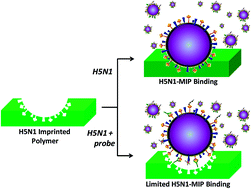In this report we investigate whether a molecularly imprinted polymer (MIP) of an inactivated strain of influenza A H5N1 could be used to help identify molecules capable of binding to, and inhibiting the function of the virus, via either competitive or allosteric mechanisms. Molecules which bind to the virus and induce a conformational change are expected to show reduced binding to the H5N1 specific MIP. Given the importance of molecular recognition in virus replication, such conformational change might also reduce the effectiveness of neuraminidase (N1) for cleaving the sialic groups necessary for virus replication. We show that the method can indeed differentiate between a potent neuraminidase inhibitor, H1 and H5 antibodies, and N1 specific and non-specific monosaccharide substrates. We suggest that such a method could potentially be used in conjunction with traditional biochemical assays to facilitate the identification of molecules functioning via novel modes of action.
Tracks information on drugs on worldwide basis by Dr Anthony Melvin Crasto, helping millions with websites, 9 million hits on google, 2.5 lakh connections worldwide, P.S. : The views expressed are my personal and in no-way suggest the views of the professional body or the company that I represent.
Subscribe to:
Post Comments (Atom)

No comments:
Post a Comment